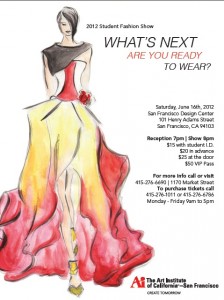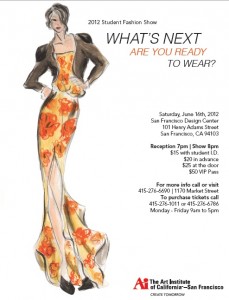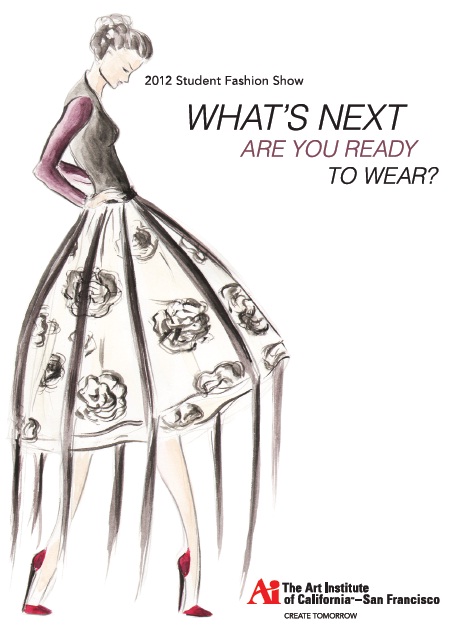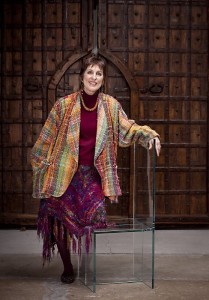Over the past three years, fafafoom has been fortunate to see the diverse, energetic emerging talents that AIC-San Francisco Fashion School produces. This year, prior to the student fashion show, we did a short interview with with Bo Breda, the Academic Director Fashion Design, Art Institute of California – San Francscisco, who was recently featured in SF Gate “Chairs of 7 S.F. fashion schools tell what’s new”.
She generously set aside some time off of her busy schedule to correspond via email about this year’s student fashion show; the process (very elaborate explanation below — those of you who are curious about student fashion show production process will likely find this useful), students involved, what to expect, and more.
fafafoom (F): In a nutshell, what is the portfolio review process look like for AIC-San Francisco Student Fashion Show 2012 (e.g. who’s reviewing and making final decisions, how many pieces need to be produced by each student, how long the process last, and selecting judges for the runway show)?
Bo Breda (BB): This is first of all NOT a graduate show. Unlike many of the other fashion design programs, we have structured our annual show in an entirely different manner, one that reflects the reality of the fashion business. We open the application process right after the previous year’s show is over (August). Any student in the FD program is allowed to enter. Naturally because of their skill levels, the upperclassmen are the ones most likely to be successful, but we have had sophomores and occasionally even a freshman make it to the runway.
As director, I receive the applications and sketches first (October) and make appointments with each student to discuss them. I give them feedback and ask them a lot of questions to help them clarify their design process. Once the sketches are approved for further consideration, they must begin the draping and patternmaking. By December they must have shown me evidence of making progress and any changes that they are contemplating. During this period naturally they begin refining their designs. Final fabric choices must be made by February.
By the end of April the completed garments are shown on live models to a panel of industry professionals. No faculty are involved during this event. The judges do not even know the names of the designers. The clothing must stand on its own. The judges give them points for overall effect, creativity/design, and construction. The top scores get into the show and the others do not. Because of this process, sometimes graduates do not make it into the show. This is very painful for them, but we consider it a first lesson in the hard facts of the fashion world.
Students are allowed to enter either a 3 to 5 piece unified collection or one stand alone gown or other special garment. They can enter as many collections as they feel they can produce, therefore, some students can show two or three collections on the runway.
The judges for the runway are often recruited by Clarissa Nicosia, the producer/director of the show, our instructor for the Fashion Show Production course. This year we have not nailed down a final list yet.
 F: What is the title of AIC-San Francisco Student Fashion Show 2012 and what can we expect to see going down on the runway?
F: What is the title of AIC-San Francisco Student Fashion Show 2012 and what can we expect to see going down on the runway?
BB: This year the title is: WHAT’S NEXT, Are you ready to wear?
(The poster was created by Mando Perez, who also did the graphic design for last year’s show. Illustration by Lia Larrea.)
Among the highlights will be a collection inspired by the bullring, several childrenswear groups, some spectacular ball gowns, an androgynous Asian inspired group, gorgeous swimwear, and a complete wedding party.
F: I’m certain that you’re very proud of your students; what are the unique characteristics that students have been showing on the AIC-San Francisco Student Fashion Show from year to year?
BB: What’s different about us is that we do not direct our students into any particular market. We know that they are the future of the business and what’s going to be important will come from them, not us. If they want to make menswear or accessories or plus sizes or something else, we let them. That is why we have an independent panel make the choices. We want the choices made by people who are completely neutral and are not swayed by personal preferences. We also do not legislate taste levels – only technical competence – again because there is so much variety in the marketplace. Because they are allowed to create what they want to, we always see things that are surprising. I expect that the bullring collection will be a crowd pleaser.
F: We have seen renewed attempt to put San Francisco on the fashion map (AIC-San Francisco alum Justin Jamison is also taking part on Macy’s Fashion Incubator program), so how is AIC-San Francisco taking part in the whole movement and what it means for the students?
BB: Yes, we are very proud of Justin and extremely pleased that Macy’s has decided to put their clout behind the move to revive what was once a thriving fashion center. Our instructors regularly take our students on field trips to local factories (yes, Mira, there are local factories in SF!) to see how clothing is made for real. During these trips students begin to make contacts with the factory owners and learn how they might use their services once they graduate.
F: Drawing from your own experience and point of view over the years you’ve been here, what is it about San Francisco that draws fashion talents to strive in (and not arguably more popular locations such as New York or Los Angeles to some extent)?
BB: I have been here 5 years and did not know much about it before I came to take the job as academic director of the fashion design program at The Art Institute of California/San Francisco. I have lived and worked all over the US and what impresses me about SF is that it is both a cosmopolitan international city and a small town at the same time. What that means is that you can come here and make contacts fairly easily. Also there are many, many creative people of all media who are able to understand the need to make new things. The tolerant atmosphere allows those with new ideas to find an audience.
F: Lastly, what advice do you always remember to give to students? And how do you keep in touch with them after they graduate?
BB: I keep in touch via LinkedIn and regular email. I still communicate with students from other schools I’ve taught in years ago. My advice is simple: be brave, speak up, work harder than everyone else, feel confident in your talent and realize that you are special.
No one enters a design school easily. The world does not in general understand what we do and often families and friends are skeptical about future success. I tell them my own war stories about the difficulties encountered in those years in the garment center, so they realize that it’s a tough field but an exciting one for those who are willing to face the challenges.
 Art Institute of California – San Francisco 2012 Student Fashion Show “What’s Next; Are You Ready to Wear” is going to be held on Saturday, June 16th at the San Francisco Design Center, 101 Henry Adams Street. We personally can’t wait to see this year’s talents, and thank you once again Bo Breda for the interview!
Art Institute of California – San Francisco 2012 Student Fashion Show “What’s Next; Are You Ready to Wear” is going to be held on Saturday, June 16th at the San Francisco Design Center, 101 Henry Adams Street. We personally can’t wait to see this year’s talents, and thank you once again Bo Breda for the interview!
Thank you for reading our Interview with Bo Breda!
Have a great day,
Musank



Trackbacks/Pingbacks